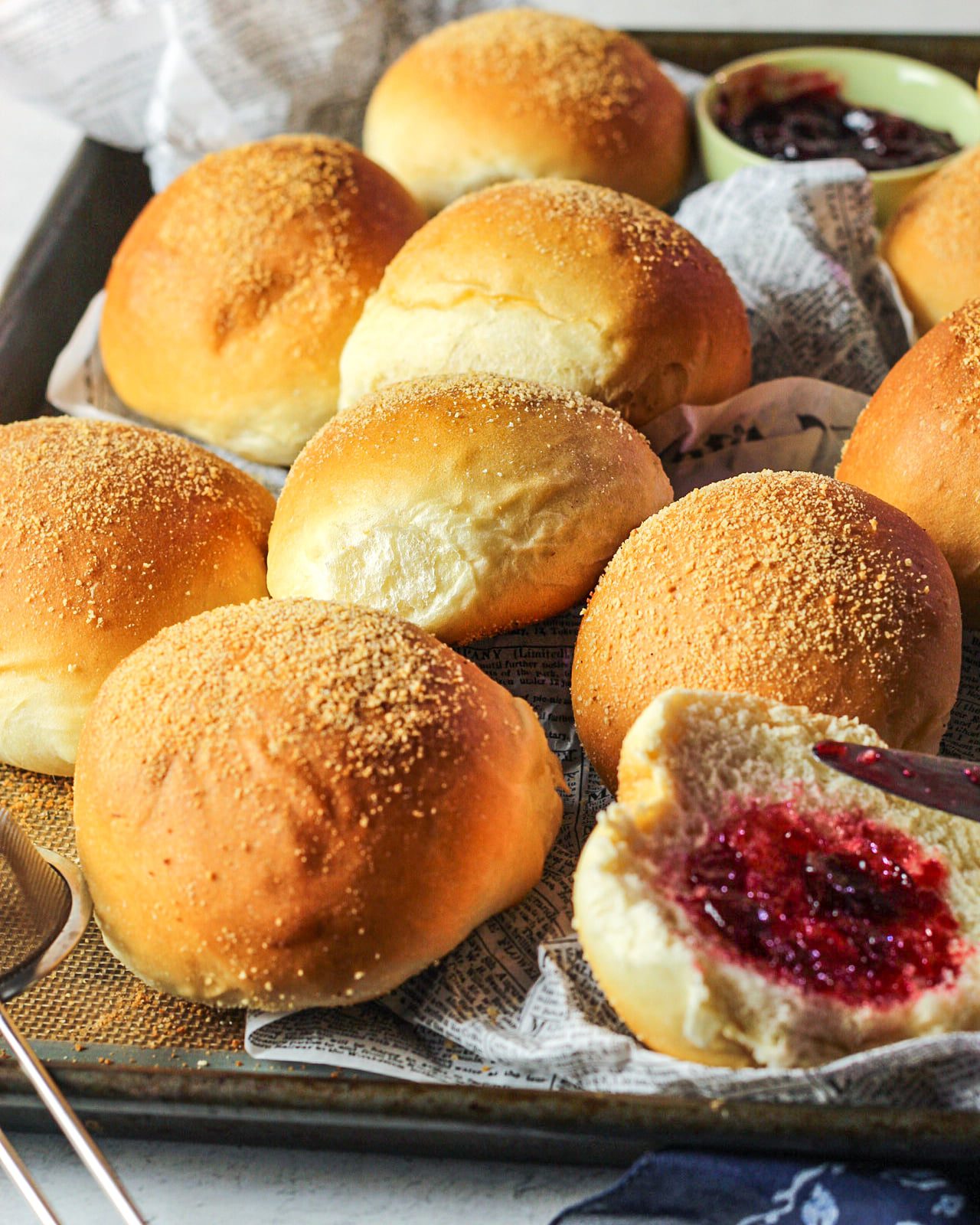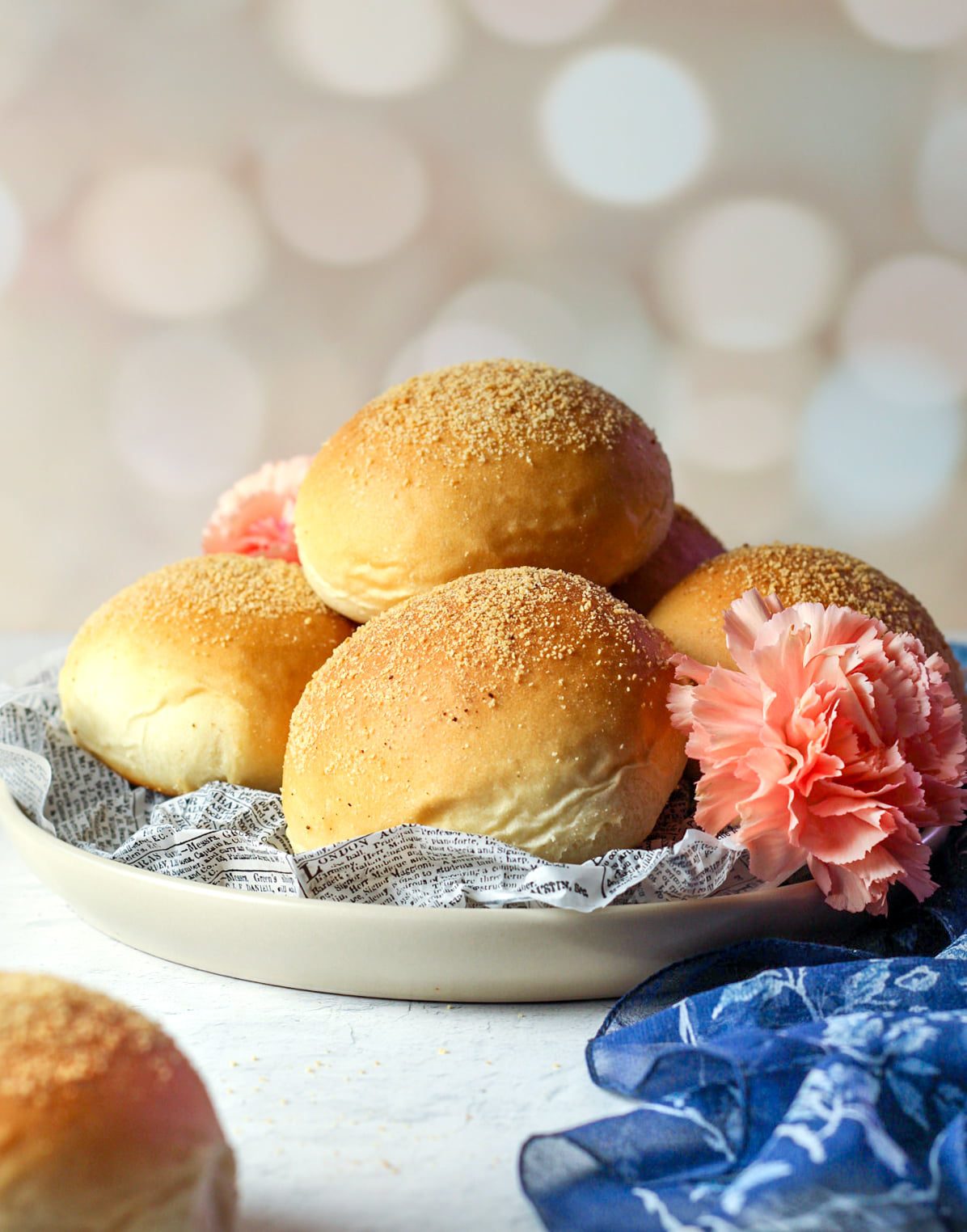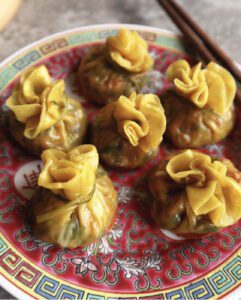Food Stories is a new column in which Best of Vegan community members share recipes from their cultures and personal stories connected to those dishes. Today, Val Latifi of Plant-Based Passport shares her recipe for Vegan Filipino Pandesal and a little bit of history of the dish.
My uncle very aggressively woke me up at five in the damn morning the last time I was in the Philippines. The year was 2014. The reason? So we could stand in line at a bakery for freshly baked pandesal. Now, I am not a morning person by any stretch of the imagination. Being rudely awoken for bread rolls, of all things, was silly at best and an invitation for violence at worst. I didn’t understand my uncle’s enthusiasm while waiting in that long, snaking queue at the bakery that day. That is, until I sank my teeth into those hot, fluffy, delicately sweetened rolls. Oh, was waking up at the crack of dawn worth the aggravation!
What Are Pandesal?
Pandesal (also spelled Pan de Sal) are Filipino yeast-risen, lightly sweetened bread rolls topped with breadcrumbs. Pandesal are typically eaten for breakfast in the Philippines. They are traditionally served with coffee or hot chocolate. Accompaniments and/or fillings can include things like butter, jam, cheese, peanut butter and scrambled eggs.


Spanish Colonial Roots
If the Philippines had a national bread, it would be pandesal. But if you’re like me, you’re asking yourself why the hell a Southeast Asian, rice-growing archipelago like the Philippines would have a national bread in the first place. Wheat? In Southeast Asia? How?
The answer, my friends, is colonialism! Wheat isn’t a native crop to Asia. It is widely believed by Filipino historians that wheat was first introduced to the Philippines by European explorers in the 1500s. Portuguese explorer Ferdinand Magellan, sailing on behalf of Spain, landed in the Philippines in 1521. The Philippines was a pitstop on Magellan’s quest to circumnavigate the globe.
Magellan went on to “claim” the Philippines for Spain. In fact, the Philippines was named in honor of Spain’s King Phillip II. And because history is written largely by white scholars with a Western, Eurocentric worldview, Magellan goes down in the history books as “discovering” the Philippines. (Um, excuse me? How exactly does one “discover” an archipelago that has been inhabited by humanoids for 700,000 years? But I digress!)
Thanks to Magellan, Spanish colonial rule lasted in the Philippines for over 300 years. When the Spanish got bored of burning down tribal villages and forcing Christianity on the natives, they decided to come up with their answer to the French baguette. They named this bread pan de sal, which means “salt bread” in Spanish.


Traditional vs. Modern Pandesal
Traditional pandesal was made with whole wheat flour. It contained only flour, water, yeast, salt, shortening and a touch of sugar. It was formed into a log, before being cut into uniform slices (called sinkit, or “narrow eyes”), rolled in bread crumbs, and then baked in a wood-fired oven. The result was a crusty, sturdy bread—owing to the high protein content of the whole wheat flour. Traditional pandesal is often compared to the French baguette or Mexican bolillo.
My parents, who are in their mid-70s, remember the pandesal of their youth as something closer to the traditional recipe of the Spaniards. They immigrated to the United States in the late 1970s, but have traveled back to the motherland several times since. They report anecdotally that the pandesal recipe most commonly available these days is something softer, richer and noticeably sweeter than the pandesal of their youth. They aren’t wrong.
Let’s back up. In 1898, the United States “liberated” the Philippines from Spanish colonial rule. Real talk, though? At the time, the U.S. was a newly found nation hell-bent on a power grab from the old colonial guard. As victors of the Spanish-American War, the U.S. won Spanish claims on Cuba, Guam and Puerto Rico, along with the Philippines. In essence, the U.S. supplanted Spanish colonial rule with their own from 1898 to 1946. The Philippines won their independence from the U.S. in 1946.
I think you know where this story is going: Where the U.S. goes, so do their cheap, highly processed foodstuffs. The Americans brought with them commercial yeast, cheap flour, dairy and sugar. This, combined with the promotion of American dietary norms, shifted the flavor profile of pandesal away from the bread’s saltier roots. Modern recipes for pandesal now include eggs, dairy and a comparatively higher percentage of sugar (4% in traditional recipes versus 18% in modern recipes). The lower protein content in the American flour made for softer pandesal—in contrast to the crustier pandesal of the Spanish. Lastly, you won’t find the traditional singkit—the mark of handmade pandesal—in the industrial iteration. Individually formed rolls have risen in popularity.
Truth be told, I grew up eating the modern version of pandesal here in the U.S. And I won’t lie: It is damn delicious, especially if you bake it yourself. It is light, rich and fluffy.
My parents requested that my husband and I write a recipe for traditional Spanish colonial-style pandesal. That recipe is forthcoming. Until then, find the recipe below for our modern version of vegan Filipino pandesal. I hope you enjoy the recipe as much as our family does!


Vegan Filipino Pandesal Recipe Notes & Tips
- Use a food scale! We highly recommend that you weigh your ingredients out on a food scale for best results. This advice applies to all bread bread baking. If cooking is an art form, baking is more of a science. To give you an example, say you measure out one cup of flour by volume with a measuring cup. The amount of flour you measure out can vary by as much as 25%, depending on how you pack your measuring cup. This can mean the difference between light-as-air bread and hard-as-a-rock loaves.
- How this recipe was veganized: Modern pandesal recipes typically contain milk, butter, and/or eggs. For this vegan take, unsweetened vegan milk and vegan butter take the place of the dairy. Eggs were omitted.


Ingredients
- 256 mL unsweetened plant milk 1 cup
- 64 mL water 1/4 cup
- 58 g plant butter 4 tbsp
- 9 g dry active yeast 2 1/4 tsp
- 5 g salt 1 tsp
- 73 g organic sugar 1/3 cup
- 480 g 4 cups AP flour, plus additional 60 g (1/2 cup) set aside for kneading
- Drizzle of neutral-flavored oil such as avocado or canola
- 1/2 cup of plain unseasoned breadcrumbs
Instructions
- Combine milk and butter in a small saucepan over low heat. Warm until butter is melted—about 3 to 4 minutes. Remove pan from heat to cool.
- In the bowl of a stand mixer, dissolve yeast in water that has been warmed (no hotter than 110°F/43°C, or it’ll kill your yeast). Set aside until the yeast softens and begins to form a creamy foam—about 10 to 15 minutes.
- Measure out 480 grams of AP flour. Measure out an additional 60 grams of AP flour and set aside for kneading. Combine the 480 grams AP flour with yeast mixture, sugar, salt, and milk mixture (ensuring milk mixture is no hotter than 110°F/43°C) in the bowl of a stand mixer fitted with a dough hook. Mix on low until no dry spots remain.
- Stir the remaining 60 grams AP flour, 2 tablespoons at time, mixing well after each addition. Continue adding flour until a firm dough forms that pulls away from the sides of the bowl. (Note: You may not need to add all of the 60 grams of flour). Knead on medium until elastic and soft but still tacky—about 7-10 minutes.
- Transfer dough to a clean bowl and coat with oil. Cover the bowl with a silicone cover or plastic wrap, and let rise in a warm spot until doubled in size—about 1 to 1 1/2 hours. Meanwhile, line a baking sheet with parchment paper or a silicone baking mat.
- Transfer dough to a work surface and shape into a rectangle about 1-inch thick. Cut into 12 equally-sized pieces. Feel free to use a food scale for accuracy.
- Shaping the pandesal: Take one of the dough pieces, keeping the rest covered to prevent them from drying out. Form into a ball, pinching the seams on the underside, to create a smooth, round top. Place the dough ball seam-side down on your work surface. Hold your hand in a “C” shape and cup the dough ball. Keeping the undersides of your pinky and thumb pressed against the work surface, move the dough ball in a slow circular motion. Then roll the top of the ball in breadcrumbs. Repeat with the remaining 11 dough pieces.
- Transfer dough balls to the prepared baking sheet in 3 rows of 4, spaced 2 inches apart. Cover and let rise in a warm place until nearly doubled—about 20 to 30 minutes. Preheat oven to 375°F (190°C). Bake in the preheated oven until golden brown, about 20 minutes. Enjoy!
Notes
PIN/SAVE/SHARE THIS ARTICLE


Article, recipe and photography by Val Latifi.









